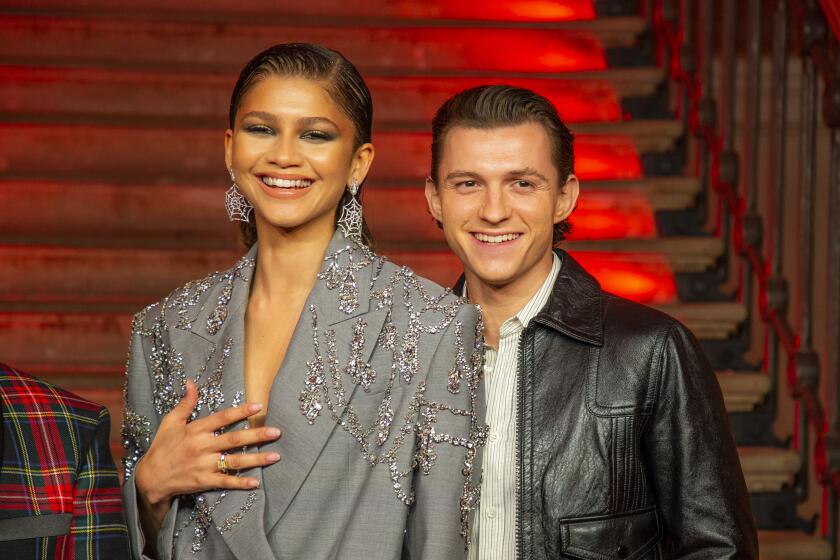How ‘Animal Crossing’ was built to be ubiquitous in coronavirus time — back in 2001
This Sunday is a holiday. One that will be a major point of discussion on social media and likely to dominate conversation among many of your friends and loved ones.
We’re talking, of course, about Bunny Day.
Bunny Day is the first major global event to occur in the recently released “Animal Crossing: New Horizons,” the latest in a two-decades-old Nintendo franchise that, while long popular, has been a pop-culture and social media sensation since its March 20 release. While Nintendo hasn’t issued sales figures, “New Horizons” is reported to have sold more than 2.6 million copies in Japan alone. Here in the states, the Nintendo Switch home video game console on which it’s played is in hot demand and essentially sold-out at online retailers.
The last proper “Animal Crossing” game, 2012’s “New Leaf,” has sold nearly 13 million copies, but “Animal Crossing: New Horizons” has already accomplished an even rarer video game milestone: It has become the sort of dominating cultural touchstone usually reserved for a new Marvel movie or the last season of “Game of Thrones.”
It’s no surprise that “Animal Crossing” has resonated, says Tracy Fullerton, a professor at USC Games and the developer of “Walden, a Game,” an exploration into the philosophies of Henry David Thoreau and a title that is currently free for educators and those home-schooling. Fullerton only slightly joked at the start of our conversation that “Animal Crossing” is the work of art that will “define this time.”
“It’s not a game game,” Fullerton says. “Many commercial multiplayer games are either, ‘You’re in, or you’re out. You’re one of us, or not.’ ‘Animal Crossing’ is trying to invite people into an experience and not a competitive arena. Right now, we are not looking for more hard challenges. We are looking for a welcoming invitation to a self-directed challenge that can get us through these times.”
At a time when we can’t meet in real life, each day brings news of “Animal Crossing” connections. The relaxed game about island life delivers capitalism with a smile — or, more accurately, capitalism is served via a plump sweater-wearing raccoon who talks us into more and more debt to build more and more stuff.
Thus far, “Animal Crossing” has housed symbolic weddings, happy hours, birthdays and, amid a very real financial panic in which many of us are losing jobs and nervous about paying rent, has created an obsession over a “stalk market,” the name coined for the game’s virtual stock market. (If you want to get rich quick in “Animal Crossing,” you need to knew when to buy — and when to sell — turnips.)
Players have even have visited a re-creation of LACMA’s “Urban Light” installation, brought to “Animal Crossing” life by Los Angeles artist/sculptor/illustrator Shing Yin Khor, who also created a riff on Marina Abramović’s “The Artist Is Present,” in which Abramović sat silently in a chair for 750 hours.
MORE ON GAMES: How USC students turned Zoom into a video game for coronavirus life
And after the University of Reading’s Museum of English Rural Life put out a call for players to design authentic-looking smocks for the game the staff was so flooded with responses that it has promised to create an “Animal Crossing” exhibition. On Monday, the Monterey Bay Aquarium will get into the “Animal Crossing” action, partnering with Chicago’s Field Museum to broadcast an educational-focused tour on Twitch through the game’s virtual museum.
“It’s a game that makes us feel like we are doing something,” Khor says, “and the things we are doing have low stakes, which is the perfect escape for a time where we’re all having trouble doing anything, and the normal things we do, like, you know, exiting our homes, feel like they have extremely high stakes.”
In this coronavirus moment, I love “Animal Crossing: New Horizons.” But I’m starting to wonder if I should devote my weekly Zoom sessions with my therapist to my “Animal Crossing” habits.
Video games are uniquely positioned to lead during our stay-at-home lifestyle, and they do so outside the confines of some of the traditional media gatekeepers. The likes of the Walt Disney Co. and NBCUniversal have largely divorced themselves from game creation, believing their content is best licensed to others, while Netflix has only tentatively dipped into interactive waters. But with so much mass entertainment on pause, games have thrived by providing evolving, social worlds, ones in which the user has the illusion of shaping.
Shortly after orders to shelter in place began to go into effect in mid-March, tech firm Verizon reported a near-immediate uptick in game playing, while computing platform Steam is setting new concurrent user records practically daily.
Competitive games such as “Fortnite” have gradually evolved to become platforms, places where we hang out to shop, chat and even watch what Hollywood has to offer. Santa Monica’s Riot Games is already touting an audience on Twitch in the low seven figures for a game that isn’t out yet, as fans tune into the online channel in the hopes of gaining early access to its upcoming tactical shooter, “Valorant.”
“The biggest barrier to playing video games is that people don’t necessarily think it’s for them,” says John Poelking, gaming analyst with market research firm Mintel. But “in a time like now, there’s going to be the people who haven’t considered it, realize there’s something for them and stick with it. The moment ‘Animal Crossing’ is capitalizing on is the need to be social without being competitive.”
As one of the most anticipated games of 2020, “New Horizons” was always going to be a hit and dissected by video game outlets such as Polygon and Kotaku. But with the game now ubiquitous in our quarantined lives, it’s become a regular on the Twitter feed of gossip podcast “Who? Weekly,” and has won a celebrity audience as diverse as electronic artist Alison Wonderland — she’s not a fan of the Bunny Day eggs — and British actor Stephen Fry, who wondered if the game was “a metaphor for life itself?”
Actually, it kind of is. And that further explains why “Animal Crossing: New Horizons” is striking a cultural nerve.
Its cute animals, daily job-like tasks — we fish, we chop wood, we build furniture and even landscape islands — are fun and provide some requisite escapism, yes, but “Animal Crossing” was built from Day One to be an antidote to hard times and loneliness. It was birthed during a recession, arriving near the end of a long period of economic stagnation that was termed Japan’s Lost Decade.
Issued in Japan in 2001, the first “Animal Crossing” initially was envisioned with grand ideas for widespread connectivity, plans dialed down due to the realities of internet sharing at the time. But its DNA as a game to unite family and friends, and to serve as a prescription for solitude, was embedded in its design.
Katsuya Eguchi, a driving force behind the “Animal Crossing” franchise to this day, has long said the series was inspired by the heartache he experienced after leaving family and friends to move from Chiba to Nintendo’s home city of Kyoto.
“Chiba is east of Tokyo and quite a distance from Kyoto, and when I moved there I left my family and friends behind,” he said in a 2008 interview with game publication the Edge. “In doing so, I realized that being close to them — being able to spend time with them, talk to them, play with them — was such a great, important thing. I wondered for a long time if there would be a way to recreate that feeling, and that was the impetus behind the original ‘Animal Crossing.’”
Games are a playground, a place to see what happens when we do what we aren’t told, and a world in which failure is embraced — welcomed, even — as a way to learn. Why play matters in times of stress.
“Animal Crossing” is rooted in both a nostalgia for small-town life and the realities of the lack of leisure time in a world recovering from recession, says Naomi Clark, a game designer and lecturer with the NYU Game Center who spent significant portions of her childhood living in Japan with her grandparents. “The pressures of modern life made it hard for everyone’s schedules to line up — all sorts of extracurricular activities and cram school for kids, some parents working late and other parents trying to run everything at home, or do a part-time job. The picture of a family who rarely gets to spend time together became increasingly common.”
Nintendo’s legendary designer Shigeru Miyamoto, the creator of “Donkey Kong” and “Super Mario Bros.,” among many other gaming staples, has spoken of how the game was envisioned as facilitating communication for such a world. Since it unfolds in real time and reflects our very real calendar — see how Bunny Day is a stand-in for Easter — it’s a game that can be played for five minutes a day or a few hours.
“Animal Crossing” works around our schedules rather than demanding time from them.
“In Japan it’s kind of ended up how I expected, where kids will go to school in the morning, and while they’re at school their mothers will pick up the game and play and leave letters for their children,” Miyamoto said at a 2006 media roundtable. “And then the children will come home from school and play the game and read letters from their mom and their mom will ask them to do something in the game. And then the dad will come home after working away at the office. He’ll sit down and play the game and will read letters from his children. And the game enhances communication that way.”
“Animal Crossing: New Horizons” is a step closer to Nintendo’s original plan, enabling players to share islands and creations with one another. One can, for instance, invite friends over for a folksy, improvised game of musical chairs — about as competitive as “Animal Crossing” gets — or simply share a space together. “ ‘Animal Crossing’ is like the more prosaic games we play with our kids — it’s a world of Fisher Price pretend games,” says Sam Barlow, the celebrated game designer behind “Her Story” and “Telling Lies,” the latter issued last year by Annapurna Interactive.
The game, Barlow says, is helping him recall an even more innocent era.
“It reminds me of the time spent with my daughter selling me plastic fruit from her plastic stall and counting out the change in cardboard coins,” he says. “These little make-believe versions of the rituals of adult life. The Richard Scarry ‘What Do People Do All Day?’ version of the world, where the complexity of society is reduced to uniforms and shop fronts and every job is fun.”
Even alone, “Animal Crossing” is full of unexpected charms. USC’s Fullerton, for instance, was enchanted the other night when she encountered a meteor shower, where the game, with each shooting star, asks players to make a wish.
“I immediately started wishing for the health and safety of every single person in my family. I waited until I got a star for every single person in my family and every person in my extended family. Then I started wishing on the health of all the people I work with and all my friends. When I couldn’t think of more people, I started doubling down on people. I wished on stars for more than an hour, wishing everyone to be safe in this time.
“And wow,” she adds, “I have never, ever, ever experienced that in a game.”
Video Games and Immersive Entertainment
The Player
More from game critic Todd Martens.











